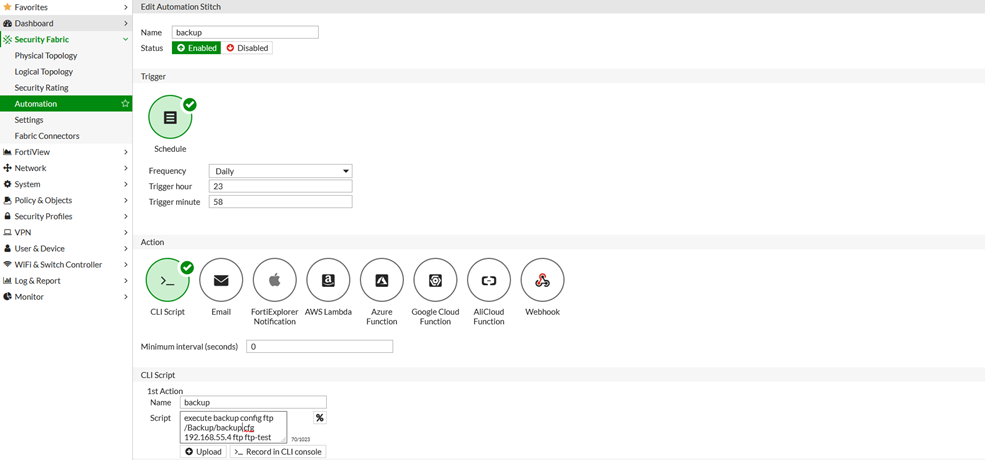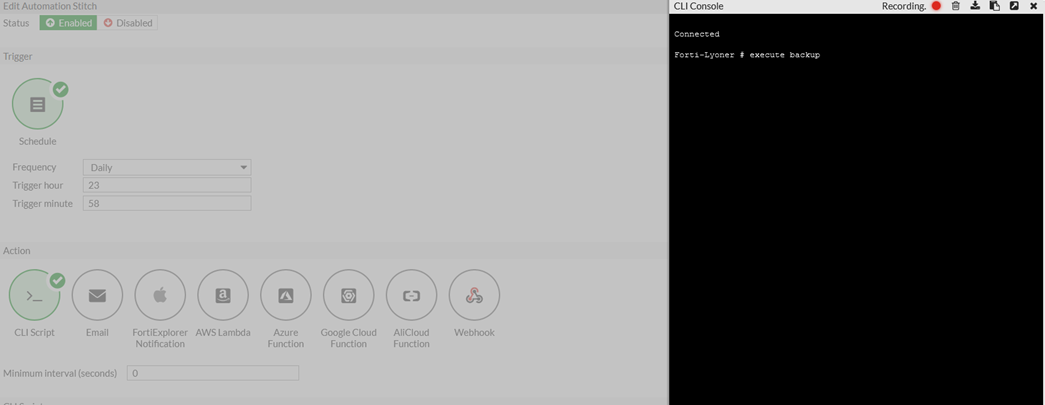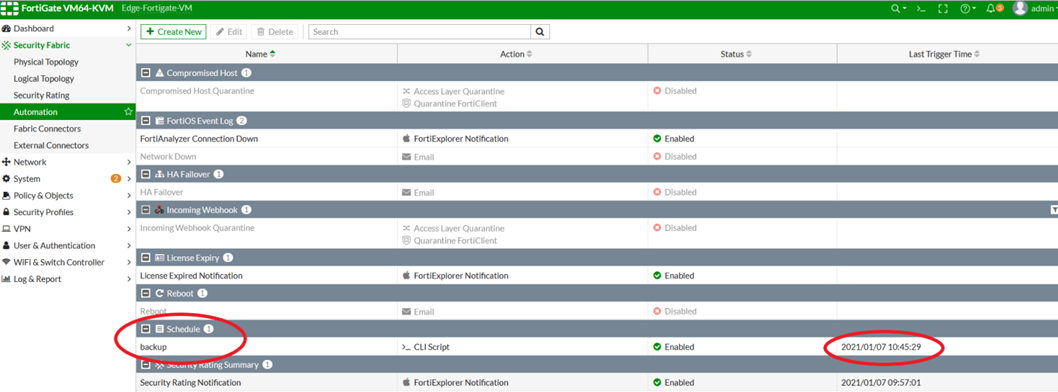- Support Forum
- Knowledge Base
- Customer Service
- Internal Article Nominations
- FortiGate
- FortiClient
- FortiADC
- FortiAIOps
- FortiAnalyzer
- FortiAP
- FortiAuthenticator
- FortiBridge
- FortiCache
- FortiCare Services
- FortiCarrier
- FortiCASB
- FortiConverter
- FortiCNP
- FortiDAST
- FortiData
- FortiDDoS
- FortiDB
- FortiDNS
- FortiDLP
- FortiDeceptor
- FortiDevice
- FortiDevSec
- FortiDirector
- FortiEdgeCloud
- FortiEDR
- FortiEndpoint
- FortiExtender
- FortiGate Cloud
- FortiGuard
- FortiGuest
- FortiHypervisor
- FortiInsight
- FortiIsolator
- FortiMail
- FortiManager
- FortiMonitor
- FortiNAC
- FortiNAC-F
- FortiNDR (on-premise)
- FortiNDRCloud
- FortiPAM
- FortiPhish
- FortiPortal
- FortiPresence
- FortiProxy
- FortiRecon
- FortiRecorder
- FortiSRA
- FortiSandbox
- FortiSASE
- FortiSASE Sovereign
- FortiScan
- FortiSIEM
- FortiSOAR
- FortiSwitch
- FortiTester
- FortiToken
- FortiVoice
- FortiWAN
- FortiWeb
- FortiAppSec Cloud
- Lacework
- Wireless Controller
- RMA Information and Announcements
- FortiCloud Products
- ZTNA
- 4D Documents
- Customer Service
- Community Groups
- Blogs
- Fortinet Community
- Knowledge Base
- FortiGate
- Technical Tip: How to send automated backups of th...
- Subscribe to RSS Feed
- Mark as New
- Mark as Read
- Bookmark
- Subscribe
- Printer Friendly Page
- Report Inappropriate Content
Created on
11-04-2016
03:01 PM
Edited on
08-14-2025
03:31 PM
By
rbernal
Description
This article describes how to send automated backups from a FortiGate to a TFTP/FTP or SFTP Server using an automated action and automation stitches, and also provides a recommendation for configuring a Linux machine.
Scope
Solution
The Automation Stitch is a feature of the Security Fabric, see FortiOS Administration Guide: Automation Stitches.
To deploy it, configure an appropriate automation-trigger, automation-action, and automation-stitch.
Note:
Firewall backup configuration cannot be sent using email at this time.
CLI example:
In this example a trigger is scheduled to perform a daily backup at 23:58 to an FTP/SFTP server 192.168.55.4 (username testuser, password testpassword) into the directory 'Backup', naming the file backup.conf.
Step 1:
config system automation-trigger
edit "backup"
set trigger-type scheduled
set trigger-frequency daily <- Frequency of the action.
set trigger-hour 23 <- Hour of the triggered action.
set trigger-minute 58 <- Minute of the triggered action.
next
end
Step 2:
config system automation-action
edit "backup"
set action-type cli-script
set minimum-interval 0 <- Limit execution to no more than once in this interval (in seconds).
set delay 0 <- Delay before execution (in seconds).
set required enable
set script "execute backup config ftp /Backup/backup.conf 192.168.55.4 testuser testpassword"
next
end
Note 1: If the FortiGate is configured with multiple VDOMs, configure the script line as below:
set script "config global
execute backup config ftp /Backup/backup.conf 192.168.55.4 testuser testpassword"
Note 2: The following configuration are available in the 6.4 branches, but they are no longer available on higher branches, such as v7.0.x, v7.2.x, and v7.4.x:
set delay 0
set required enable
Starting from branch v7.0, if the above-stated commands are executed, the following error will show:
The available options in these versions are as follows:
- Branch v7.0:
- Branch v7.2:
- Branch v7.4:
- Branch v7.6:
If the FortiGate is configured with multiple VDOMs, configure the script line as below:
set script "config global
execute backup config ftp /Backup/backup.conf 192.168.55.4 testuser testpassword"
When using SFTP for transferring the backup and the FortiGate is configured with multiple VDOMs, the script above will change only the protocol, as below:
set script "config global
execute backup config sftp /Backup/backup.conf 192.168.55.4 testuser testpassword"
Step 3:
config system automation-stitch
edit "backup"
set status enable
set trigger "backup"
set action "backup"
next
end
Execute backup breakdown:
execute backup config ftp /Backup/backup.conf 192.168.55.4 testuser testpassword
- 'execute backup config' will back up the current saved configuration.
- 'ftp' specifies to backup the file to the FTP server.
- '/Backup/backup.conf' assigns this file name and path to the backup on the FTP server. Note that if the folder path does not have '/backup/' specified, the FTP server will save the file into the 'default' FTP folder. Optionally, add the variable %%date%% to name the backup with the current date stamp. For example: 'backup-%%date%%.conf' would be saved as backup-2023-01-11.conf.
- Moreover, optional variables such as '%%log.devid%%” and “%%log.devname%%' can be added for serial number and the device name.
- '192.168.55.4' is the FTP server's IP. A port can also be specified. For example, 192.168.55.4:2323.
- 'testuser' is the username of a user with read/write permissions on the FTP server.
- 'testpassword' is the above user's password.
Note:
1. On the automation-action CLI Script, it mandatory to select the super_admin in the Administrator Profile.
Without super_admin, the full config file will not send via TFTP/FTP or SFTP server to destination Folder.
If a different profile is selected, the file will be missing some configuration including at minimum any existing super_admin accounts and may be missing firewall policies, security profiles etc.
2. If the 'execute backup config' is manually run on the CLI, variable names will not be replaced with their values, ie '/home/fortigate/backups/Backup%%date%%-%%log.devid%%.conf' would be saved as it is on the server. Try triggering the complete stitch, only then, the actual date and serial number for the FortiGate.
Refer to this KB article: Technical Tip: Explanation of Log Action Parameters in Automation Scripts.
Note that the user and password that is defined in the automation stitch will be saved in clear text in FortiGate backup.
GUI example:
Go to Security Fabric -> Automation. In the Trigger section, select Schedule. In the Action section, select CLI Script.



FTP server reachable through an IPSec VPN:
In many environments, the FTP server used to store backups is in another location and is reached by IPSec VPN.
In this case, the traffic generated by the FortiGate automation stitch will be sourced with WAN or the MGMT IP by default. This traffic may not be allowed.
To solve this, it is possible to address this using the preferred-source feature in FortiOS v7.4 and later, see Technical Tip: Directing FortiGate TFTP Backup Traffic Using a Specific Source IP Address.
In earlier firmware versions, it is necessary to configure an IP address for the IPSec interface on the source FortiGate.
In either case, it is necessary to allow this communication [Interface IPsec IP]->[FTP_Server] in encryption domains of VPN and firewall policies on the Remote side.
Here is a diagram example:

Configurations for this example:
FortiGate_Source:
config vpn ipsec phase1-interface
edit "To-DataCenter"
set interface "port1"
set peertype any
set proposal aes128-sha256 aes256-sha256 aes128-sha1 aes256-sha1
set remote-gw <DataCenter_Public_IP>
next
end
config vpn ipsec phase2-interface
edit "To-DataCenter_FTP"
set phase1name "To-DataCenter"
set proposal aes128-sha1 aes256-sha1 aes128-sha256 aes256-sha256
set src-subnet 10.254.254.254 255.255.255.255
set dst-subnet 192.168.55.0 255.255.255.0
next
end
config system interface
edit "To-DataCenter"
set ip 10.254.254.254 255.255.255.255
set type tunnel
set interface "port1"
next
end
config router static
edit 0
set dst 192.168.55.0 255.255.255.0
set device "To-DataCenter"
next
end
FortiGate DataCenter:
config vpn ipsec phase1-interface
edit "To-Fortigate"
set interface "port1"
set peertype any
set proposal aes128-sha256 aes256-sha256 aes128-sha1 aes256-sha1
set remote-gw <FGT_Public_IP>
next
end
config vpn ipsec phase2-interface
edit "To-Fortigate_FTP"
set phase1name "To-Fortigate"
set proposal aes128-sha1 aes256-sha1 aes128-sha256 aes256-sha256
set src-subnet 192.168.55.0 255.255.255.0
set dst-subnet 10.254.254.254 255.255.255.255
next
end
config router static
edit 0
set dst 10.254.254.254 255.255.255.255
set device "To-Fortigate"
next
end
config firewall address
edit "To-Fortigate_remote_subnet_10.254.254.254"
set subnet 10.254.254.254 255.255.255.255
next
edit "To-Fortigate_local_subnet_192.168.55.0/24"
set subnet 192.168.55.0 255.255.255.0
next
end
config firewall policy
edit 0
set name "FTP_AUTOBACKUP"
set srcintf "To-Fortigate"
set dstintf "port4"
set srcaddr "To-Fortigate_remote_subnet_10.254.254.254"
set dstaddr "To-Fortigate_local_subnet_192.168.55.0/24"
set action accept
set schedule "always"
set service "ALL"
set nat enable
next
end
A recommendation for configuring a Linux machine for SFTP:
- Configure the IP address, subnet mask, and gateway on the Linux machine from the GUI:
Go to: 'Settings' -> 'Network' and configure the IP address, subnet mask, and gateway, on the port to which it is connected with the FortiGate.
In this case, Kali Linux is chosen as a Linux machine. To connect the FortiGate with the Kali Linux, the following IP address is configured from the FortiGate: 10.108.20.123/20.
- Update the system on Kali Linux. To update the system, Internet connectivity, and DNS resolution are needed to resolve: 'kali.org'. To set these up, perform the following steps:
- Create a Firewall Policy on the FortiGate. In this example, it is configured as below:
Port2 is used for Internet connectivity.
Port3 is used for the connection with the Kali Linux.
- As shown below, it is possible to ping 1.1.1.1 but it is not possible to resolve: 'kali.org':
To be able to resolve the domain, execute the following command:
After executing the above command, the following output is received. In the following output, write 'nameserver 1.1.1.1', as below:
To save the above output, press CTRL + O -> Enter. To exit, press CTRL + X.
After the above steps, 'kali.org' will be reachable and DNS will be able to resolve 'kali.org':
- Execute the following commands to update the system:
sudo apt update
sudo apt upgrade
- Run the following commands to install, enable, and start the SSH. SFTP relies on SSH to transfer files securely.
sudo apt install ssh
sudo systemctl enable ssh
sudo systemctl start ssh
To check the status of SSH, run the following command:
sudo systemctl status ssh
- Run the following command to create an SFTP group where users that will access files using SFTP will be added:
sudo addgroup sftp
Create a user or users that will have access to SFTP and write the password by running the following command:
sudo adduser user <- In this example, 'user' is the name of the user.
New password: Fortinet
Retype new password: Fortinet
Full Name: Name Surname
Add the user or users that were just created to the SFTP group:
sudo usermod -a -G sftp user <- 'user' is the name of the user.
Verify the SFTP group by running the following command:
grep sftp /etc/group
- Create a directory that users can access:
sudo mkdir -p /var/sftp/Files
Set the ownership of the directory to the root user:
sudo chown root:root /var/sftp
Change the access permissions of the directory by running the following command:
sudo chmod 755 /var/sftp
Allow access to the 'Files' directory to the user that was created by running the following command:
sudo chown user:user /var/sftp/Files<- 'user' in both cases is the name of the user.
- Execute the following command to open the SSH configuration file:
sudo nano /etc/ssh/sshd_config
Add the following script on the bottom of the SSH configuration file, as shown in the screenshot:
Match User user
ForceCommand internal-sftp
PasswordAuthentication yes
ChrootDirectory /var/sftp
PermitTunnel no
AllowAgentForwarding no
AllowTcpForwarding no
X11Forwarding no
Explanation of the settings:
Match User: Limits the following directives to the specified user (replace user with the user's name if needed).
ForceCommand internal-sftp: Ensures the user is restricted to the SFTP protocol, blocking shell access.
PasswordAuthentication yes: Enables password authentication for the user.
ChrootDirectory /var/sftp: Restricts the user to this directory, blocking access to any parent directories.
AllowAgentForwarding, AllowTcpForwarding, and X11Forwarding: These disable forwarding capabilities to restrict server access further.
To save the script, press CTRL + O -> Enter. To exit, press CTRL + X. To be sure that the script is saved, execute the following command again and go to the bottom of the script:
sudo nano /etc/ssh/sshd_config
- Restart the SSH service with the following command:
sudo systemctl restart ssh
- Check if the backup is transferred via SFTP after the scheduled time with the following command on the Linux machine:
find /var/sftp/Files -print -ls
As shown in the above screenshot, the backup configuration file is transferred successfully at the scheduled time on the Linux machine.
Related article:
Technical Tip: Looping Automation Stitch in Security Fabric Setup
Technical Tip: Automatic backup and precautions using date variables
The Fortinet Security Fabric brings together the concepts of convergence and consolidation to provide comprehensive cybersecurity protection for all users, devices, and applications and across all network edges.
Copyright 2026 Fortinet, Inc. All Rights Reserved.











